During the continued COVID 19 Curfew, I have decided to indulge myself and return to the subject that pretty much got Forgotten New York started in the first place: lampposts. I can’t call it an obsession — I pride myself with not being unhealthily obsessed with anything — but I first became aware of lampposts when the Great Mercury Shift happened in the early 1960s (I was six), when vast flocks of ornate incandescent-bulbed castiron posts were replaced with unadorned octagonal-shafted poles carrying whitish-green mercury lamps, and the new Donald Deskey posts were introduced to carry them. Who knows why individuals like anything? It’s just brain chemistry, you like what you like. My enthusiasm for lampposts blossomed into an enthusiasm for infrastructure in general, and the website and books followed. Well, it gets me out of bed in the morning.
So in 1994, the Landmarks Preservation Commission published a pamphlet, Inventory of Historic Street Lamps in the City of New York, listing every lamppost/signal that had been given LPC protection up to that point, with maps, drawings and photos: a lampophile’s dream. In the pamphlet, an earlier publication, The System Electric Companies: Photographs of Street Lighting Equipment as of 1934 is cited. As it happens I have copies of both, obtained from NYC’s 1990s King of Lampposts Jeff Saltzman and his successor after Jeff moved to North Carolina, Bob Mulero. Each publication classifies the posts by number and/or letter, as determined by the Bureau of Gas and Electricity (the NYC utilities currently handled by Con Edison).
In 1994, NYC’s castiron lamppost revival was starting. Between 1950 and 1980, no new castiron poles, be they bishop crooks, Corvingtons, or any species were installed by the modern Department of Transportation. Then, in 1980, new bishop crooks appeared at the Villard Houses, then the Helmsley Palace, at Madison Avenue and East 50th. The race was on! Retro versions of classic castirons suddenly began appearing along NYC’s major thoroughfares, and the program continues today.
Because of the retro versions, it can be difficult to spot the classic versions that have been standing since the 1910s, with the latest appearing in the 1940s. “For those who care,” the Landmarks Preservation Commission pamphlet is a big help. It lists NYC’s “protected poles” from 1 to 77, with the lion’s share in Manhattan; in that borough, the landmarked poles tend to cluster in certain neighborhoods. I’ve decided to list them here; as well as several “countdown extras” that can be found around town, but for some reason did not make the list.
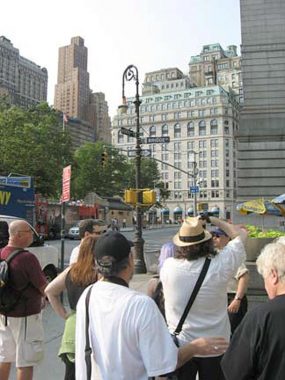
1. Bridge and State Streets, Financial District
Type: 24A Status: Demolished
The Type 24A wasn’t the first NYC bishop crook lamppost design; it had been preceded in the early 20th Century by the Type 1 BC which was the first of 6 separate bishop crook variants, only three of which survive. Today’s modern bishop crook reproductions are based on the Type 24A; however, they incorporate the 1 BC garland design wrapping around the shaft. Type 24As are cast iron at the base and lower shaft, with the upper shaft wrought iron.
Though this one made it through the 1990s, it was unceremoniously torn down during the 2000s with a standard octagonal-shaft post taking its place. This one had been fitted with a Holophane sodium-yellow bucket fixture with an unusually lengthy pipe holding it in place. I used to disparage the sodiums, but I find their yellow light much more soothing than the modern bright white LED lamps.

2. Broad and Pearl Street, Fraunces Tavern
Type: 24A Status: Missing, at least for now
This Type 24A Crook had presided the corner in front of landmarked Fraunces Tavern, itself a 1905 “reimagining” of the colonial-era tavern patronized by George Washington, since the 1910s. Formerly there was a fire alarm indicator lamp bracket that has since been stripped away. In 2019, building repairs necessitated its removal, and we’ll have to see whether it returns.

3. 24 Beaver Street between New and Broad Streets
Type: 1BC Status: Holding firm
This post is one of NYC’s few remaining Type 1 BC, among the earlier species of the beast. It’s marked by its short stature, thinner shaft, and garland ornament encircling the post. Type 1 BCs are entirely cast iron. They also have a ladder rest, a callback to an even earlier era when gas lamp lighters rested their ladders. Many Type 1 BCs also have a lightbulb logo, for the Edison Company, on their bases.

4. 50 Broadway between Morris Street and Exchange Place
Type: 24A Status: Hanging in
One of two remaining Crooks on lower Broadway, it’s received a new black paint job in recent years. Traditionally, NYC’s castiron poles have been chocolate brown.

5. Broadway at One Wall Street
Type: 1 BC Status: Survivor
In 2005, this post was removed and restored with a new paint job and a Type 24A “crown” which makes this post a hybrid of sorts. (Compare the Beaver Street “crown” seen above.) Note the anti-terrorism bollards.

6. Pine Street between Broadway and Nassau Street
Type: 24A-W Status: OK but hard to see
The Type 24A-W is a newer variant of the older Type 24A. It’s somewhat taller than the 24A and has a simplified scroll design in the crown that is wrought iron instead of cast iron. Some 24A-Ws (but not this one) are missing the shaft capital just beneath the crook.
This one on Pine Street is somewhat hard to photograph on this perpetually shaded street, which often has a sidewalk shed partially obscuring the post.
7-13. Along Greenwich Street north to Edgar Street
Type: 24-M “Corvington,” Status: Some good, some not so good
The streets on either side of the Brooklyn Battery Tunnel exits, Greenwich, Washington, and Morris, are NYC’s largest depositories of remaining Type 24M long-armed Corvingtons. Original 24Ms go back to 1915 or so and were originally used on wider boulevards, but later were used on narrower streets like this. The scrollwork was originally more elaborate and has been simplified. Similarly, the teardrop pendant lamps originally had oval designs that have long vanished but have resurfaced in some reproductions.
Along the tunnel exit, some of these posts have been moved around somewhat and are the worse for wear. On the Landmarks list, #8 and #12 posts have been removed since 1994.
14-15. Washington and Morris Streets west of the Brooklyn Battery Tunnel
Type: 24-M Status: OK
Here’s a venerable pair of Corvingtons that can be found on the orphaned piece of Morris Street between Washington and West Streets. They are a variant of the usual 24M in that they’re a bit shorter. Unfortunately in the 1980s they were given modern sodium fixtures that replaced earlier Bell pendant lamps. The one on Washington Street was removed for repairs in 2019, and I was relieved when it came back.
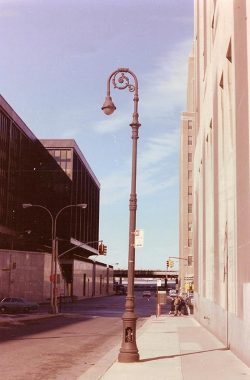
16. Vesey Street between Church Street and West Broadway
Type: 24A Status: Smithereens
This Type 24A bishop crook was waylaid when terrorists destroyed the World Trade Center on 9/11/01.
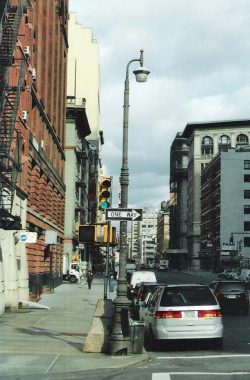
17. Hudson and Duane Streets
Type: 24A (Modified) Status: Demolished
This post, which started out in the 1910s or 1920s as a regulation Type 24A bishop crook, underwent some massive adjustments after some mishap occurred with its crown. The Department of Transportation had no replacement crowns (new ones wouldn’t be manufactured in bulk until the 1980s) so they improvised with what was lying around, installing a curved pipe with a Holophane bucket attached. Bob Mulero photographed its evolution.
A couple of years ago the shebang was repalced with a retro version Type 24A crook.
18. 86 Thomas Street between West Broadway and Hudson Street
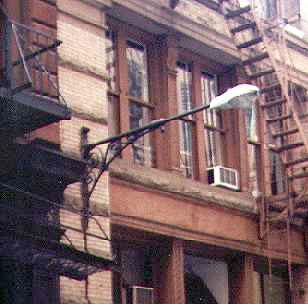
Type: G wall bracket Status: Long gone
There are certain locations in Manhattan where space is at a minimum and there was deemed insufficient room on the sidewalk to install a full-size lamppost, so lamps were placed on wall bracketed shafts. Many were based on Type G Corvingtons (see below).
Oddly enough this was the only landmarked Type g wall bracket, and it’s been gone for almost 20 years. As we’ll see, there are others around that haven’t been given landmarked status.
19. Reade Street between Lafayette Street (Foley Square) and Elk Street
Type: 24A-W Status: Hanging in there
This is a classic Type 24A-W Crook standing at the rear entrance of the old Beaux Arts Hall of Records (now the Surrogates’ Court). As you can see it’s missing its shaft capital below the crown. What I’m uncertain about is whether this was a design feature, or was there a capital there originally?
Elsewhere on Reade, there were some really ornate, wild castiron posts, none of which made it out of the 1960s. Here’s a 1940 photo.
20-22. Cardinal Hayes Place, Kent Place, Worth Street
Type: 24-A Status: Gone but replaced with retro versions
There’s a warren of short streets and passageways behind Manhattan’s civic center: the Municipal Building, Daniel P. Moynihan Courthouse, and NYPD headquarters consisting of Cardinal Hayes Place (formerly City Hall Place) and pedestrian passageway Kent Place, between the two latter. There were three landmarked bishop crooks in this warren; I only have two photos of them, courtesy Bob Mulero. They had vanished by the mid-1990s, but replaced with plenty of retro crooks.

23-24, 27-34: City Hall Park
Type: 8 Type 1 BC; 1 Type 24A; 1 Type 24A-W Status: Unrecognizable
City Hall and its park, where Broadway and Park row (formerly part of the post road to Boston) have been the centerpiece of lower Manhattan since 1812; at that time the back end was fashioned in plain bricks, since its architects Joseph-François Mangin and John McComb Jr. did not envision the city expanding north of it very quickly and they wanted to save money.
City Hall Park, about half of which (the lower half) is open to the public, is the largest repository of early-era Type 1 BC lampposts in New York City. However, that was mitigated in the 1990s by a large restoration program that severely modified the appearance of the original poles; most notably by the addition of new globe ornaments on the teardrop lamps that harks back to the original design. By the 1920s, those ornaments had been stripped off. Additionally many of the posts carry obtrusive surveillance equipment, sadly necessary in the modern era.
25-26: City Hall Park

Type: A pair of Type 24 Twin crowns placed on Type 1 BC shaft Status: replaced with retro version Twins
There are a pair of hybrid posts in the plaza directly in front of City Hall that match a Twin “crown” on top of what had been a Type 1 bishop crook shaft.
Variations of the Twin can be found mostly on 5th Avenue but they were also used on wide boulevards such as Queens Boulevard and Horace Harding Boulevard (now the LIE). They also found a home on 7th Avenue above 14th Street. They come in several different versions, a few of which survive.
This section of City Hal Park has been closed to the public since the terrorist attack on 9/11/01.
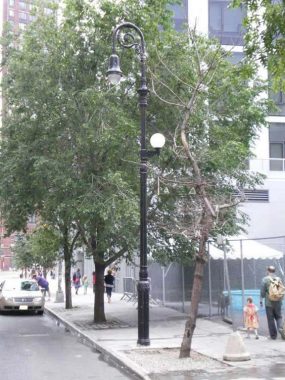
Countdown Extra: Warren Street bishop crook
Type: 6 BC Status: Restored
This classic bishop crook on Warren Street between Washington and West Street was surprisingly left out of the LPC’s inventory of historic street lamps, but it was extant in 1994 when it was published, though it did indeed have Landmarks protection’ perhaps it was bestowed after 1994.
In 1999 I was stumbling around in lower Manhattan, in that little-defined area south of Independence Plaza and north of the northern edge of the World Trade Center plaza at Vesey Street, when I happened upon a parking lot facing Warren Street along with a dead-end stub of Washington Street complete with Belgian blocks, with the scene completed by the presence of a hybrid Bishop Crook lamppost combining a Type 24 BC mast and a Type 6 BC base, the type usually employed on narrower streets. This one even had an old-style fire alarm lamp sconce.
By the mid-2000s, this block was finally developed, with 100 Greenwich Street going up on the plot, erasing this small piece of Washington. However, the bishop crook was landmarked and could not be scrapped. What could the Department of Transportation do? They removed the post, gave it a paint job and in an unusual maneuver, placed a large white reflector globe in place of the small orange fire alarm indicator. The post was relocated to the north side of Warren Street, where it stands today.
The lamp is classified as Type 6 BC, and the differences are apparent: most obviously the base is a narrower, simpler design. For the most part these lamps, which were used by the flock in lower Manhattan, were used on narrower streets and sidewalks. The crown scrollwork was simplified in some cases, as well.

35. Canal and Lafayette Streets, Chinatown
Type: 1 BC Status: Intact, but overloaded
There’s an original Bishop Crook lamppost from the 1915 era on the southeast corner of Canal and Lafayette, a Type 1 BC, one of the first types produced. It is marked with plaques from the J.L. Mott Iron Works, formerly in the Mott Haven Bronx neighborhood, and the light bulb symbolic of the Edison company, which produced the original batch of castiron lampposts. The post has so many signs and electric stoplights affixed to it that I hope it’s weighted sufficiently. It has survived nearly 9 decades of Canal Street truck traffic! The Holophane sodium bucket lamp is just the latest of the many light fixtures it has supported.

Countdown Extra: Centre and Grand Streets
Type: 1 BC Status: intact but rusty
In February 2010 I wrote about the Type 1 BC bishop crook post at Centre and Grand Streets in SoHo (across from the former NYPD HQ) and its accumulated rust. King of NYC Lampposts Bob Mulero reports that the rust problem hasn’t really been alleviated, and the near-century-old post, with its gaslamp ladder rest hommage, seems to be listing a bit in the aftermath of recent roadway construction. This one was not included in the LPC pamphlet, though I imagine it does indeed have Landmarks protection.
It has, however, been given a new Bell fixture, replacing the sodium-lamp “bucket” it had sported since the mid-1980s.
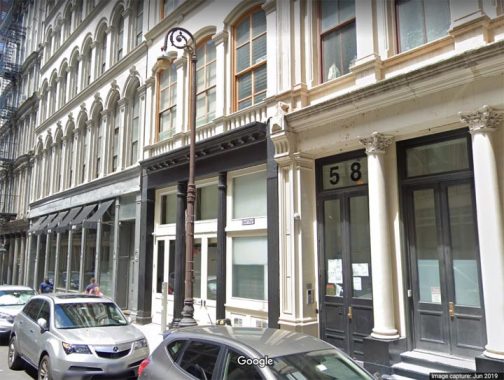
36. 56 Walker Street west of Broadway
Type: 24A-W Status: Hanging in
This Type 24A-W is in the midst of the castiron building district that dominates Tribeca and SoHo. It sports a 1980s “bucket” fixture that shines bright yellow, but unlike the others, this isn’t a Holophane.
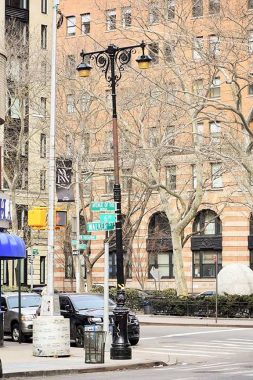
Countdown Extra: 6th Avenue at Walker Street
Type: 24 Twin Status: Bloody but unbowed
This Tribeca Twin has seen its share of ups and downs. It has already surrendered its center finial (at the top of the shaft) and was listing considerably before road repairs in 2018 forced its removal. Though it’s not in the pamphlet, it has Landmarks protection, so the Department of Transportation was forced to reinstall it, with a new black paint job (well, most of it) that included its two Holophane buckets.

37. 444 Broadway north of Howard Street, SoHo
Type: 24A Status: Good
Along Broadway’s great length there are a number of classic Bishop Crooks in preservation, from the Battery as far north as Riverdale.
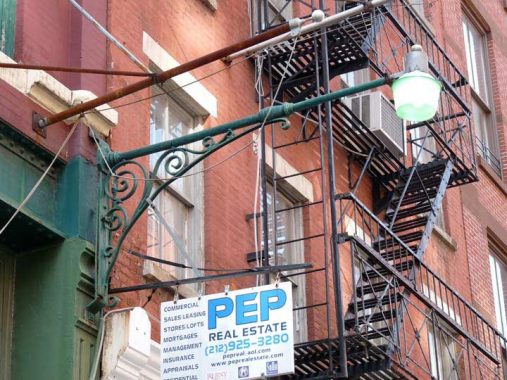
Countdown Extra: 39 Wooster Street north of Grand Street
Type: G wall bracket Status: Hanging around
Here’s an unusual Type G wall-mounted shaft at 41 Wooster Street north of Grand. It’s the only NEMA luminaire in public use, though I’m not sure if the Department of Transportation services it. When I shot it a few years ago it had a day burning Mercury vapor bulb. Note the rusted, unused flagpole alongside.
By 2019, the building exterior, along with the mast, had been painted black, and the lamp was missing its reflector shell.

38. 473 Broadway between Grand and Broome
Type: 24A Status: Replaced
In the 1990s, this stretch of Broadway was bestowed a set of retro bishop crooks, so the remaining ones from the early 20th Century blend in quite well, such as this one. How do you tell them apart? Once again, the repros have a shaft garland; the old Type 24As do not.
Per Bob Mulero this is a garlanded remake.

39. 515 Broadway between Broome and Spring Street
Type: 24A Status: Holophane glory
Can a Holophane sodium fixture be considered classic? They’ve been on NYC lamps for over 30 years now.
515 Broadway is an 1884 classic in its own right.

40. 60 Greene Street north of Broome
Type: 24A Status: removed
The Type 24A crook at #60 Greene has been replaced by a garlanded retro version. It succumbed in 1997.

Countdown Extra: Sheriff Bishop at Broome Street
Type: 6 BC Status: Miracle it’s still there
I’ve written about this rusted, abandoned lamppost often, as it’s among my favorite bits of infrastructure in the city. It’s survived because it sits on a strip of undeveloped territory at the back of a Delancey Street park. It once stood at the intersection of Broome and Sheriff Streets; Broome Street carries on here as a narrow strip of road between Willett (Bialystoker Place) and Columbia (Abraham Kazan) Street in this one-heavily Jewish part of town. Sheriff is one of those north-south streets on the far east side obliterated by housing projects.
The post still has remnants of its ladder rest and fire alarm lamp bracket.
Retuning to SoHo…

41. 540 Broadway between Spring and Prince
Type: 24A Status: Replaced
I’m not sure if this is a replacement repro, or a refurbished original. It has the shaft garland, which was not on the original 24As, but does appear on the new repros.
Bob Mulero confirms this is a replacement.

42. 580 Broadway between Prince and Houston Streets
Type: 24A Status: Replaced
I have the same observation about this one (see #41 above). Bob Mulero confirms this is a replacement.

43. 152 Mercer Street between Prince and West Houston
Type: 24A Status: Heavily damaged
Bob Mulero juxtaposed two shots of this SoHo post, taken in the 1980s and 1990s. (the post in the background is a modern reproduction). As you can see it has lost its shaft capital, as well as most of the scrollwork in the crown, and it’s listing just a bit. Semper fidelis!

Countdown extra: West 10th and Greenwich Streets
Type: 24A Status: Rusty but hanging on
A battered, weathered, deteriorated, blasted, neglected, degenerated, atrophied, but yet compellingly importunate post that has been flaking away for ninety years or more. It’s survived the collapse of the adjoining building, so a bit of rust shouldn’t mean much. It must be landmarked, but it’s not in the pamphlet.

44. End of Patchin Place, West 10th
Type: Original gaslamp Status: ‘Lectrically they keep a baseball score
This is the only remaining NYC lamppost that can be documented as starting out gas-powered. (There is a similar post on Broadway and West 211th in Inwood that may or may not have been one.) Many years ago it was given an electrically-powered luminaire on this dead end court just west of 6th Avenue that has been home to literary “luminaries” such as e.e. cummings and Djuna Barnes.

Countdown extra: West 10th opposite Patchin Place
Type: 1 BC Status: Damaged
West 10th was batting only .333 with the Landmarks Preservation Commission in 1994, as only one of its three classic lamps had been included in the pamphlet. This Type 1 BC originally stood on the corner of West 10th and Patchin, but it was moved across the street to a driveway for the Jefferson Market Library about 20 years ago, with a modern repro taking its place. It’s still there, but was behind a construction barrier when I walked 10th Street in early 2020. It has been without its crown scrollwork for as long as I remember it, wherever it’s been.
45. Gansevoort Street between Hudson Street and 9th Avenue

Type: 24M Corvington Status: Kaput
This 24M had had its old pendant lamp replaced by a modern sodium model by the time I found it in early 1998; it was rusted and leaning over. Soon after that it was replaced by a modern bishop crook repro.
Though it had been landmarked it was apparently too far gone to save.

46. 135 West 13th Street between 6th and 7th Avenue
Type: F Status: Battered but still there
This is a rare original Type F survivor, a style that once flocked the side streets of Manhattan like pigeons. It’s sort of an alternative to the diminutive Type 1 BC crooks. Starting in the 1950s there was a persistent program to slay them, and most original Type Fs have vanished except for a few select areas. But a revival has begun, as larger versions have been installed on 8th Street and Wyckoff and Metropolitan Avenues in the “hinterlands.” According to NYTimes’ late Christopher Gray they were reportedly designed in the 1910s by Charles F. Lacombe, at the time the city’s chief engineer for light and power (he has an avenue in Soundview, the Bronx, named for him).
I haven’t been by at night, thus I’m unsure if its Westinghouse “cuplight” works. Its top finial is long vanished. Many surviving Type Fs have suffered this malady.
Type F is one in a series of lettered NYC lamps from A to G.
47. 5th Avenue and East 17th Street

Type: #3 Twin Status: Demolished
This was the first Twinlamp design to be installed on 5th Avenue in 1896, and one of the first electrically-powered posts to be mass produced. The unique designs had a sphere and decorative ironwork at the top of the shaft that included springs and a ladder rest. By the time Bob Mulero snapped this one in the 1980s, much of its details had been wiped out.
By the mid-1910s, production stopped on these posts, which were mainly used on 5th Avenue while some found their way to 7th.
After that, Type 24 Twins were installed on 5th, and it’s that style that we see on remaining 5th Avenue Twins. When the streets around City Hall Park received decorative Twins in 2001, they were styled similarly to these.
By 2020, this post at 5th Avenue and East 17th (and a second at East 15th) had been gone for 25 years or so.

48. 5th Avenue and East 19th Street
Style: Type 24 Twin Status: Hanging tough
When Type 3 Twins began to vanish, Type 24 Twins took over, and gradually replaced the 3s, though the two styles stood together on 5th Avenue until 1965, when twin bronze Donald Deskey poles replaced them for the most part. However the city allowed a few to remain, and by 1994 most of them had attained Landmarked status.

49. 5th Avenue and West 23rd, SW corner
Type: 24 Twin Status: Truck got it
Until 1990 or so, the intersection of 5th Avenue, Broadway and 23rd Street, Madison Square, had four remaining Twins, two Type 24s, one Type 3, and a hybrid post (see below) but their number has been reduced to two. This one remained in place until about 2010 when a careering truck spelled its doom.
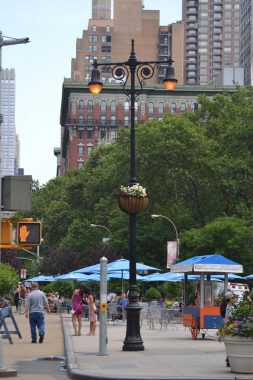
50. 5th Avenue, Broadway and East 23rd
Type: 24 Twin Status: Holding on
You would think this Twin, in the traffic island at Madison Square, would be ripe for attack by motor vehicles, but it’s hung tough over the decades, and now that Broadway has been turned into a pedestrian walkway along Madison Square Park, its chances are looking up.
In a neat trick not duplicated elsewhere, its 1940s-era Bells were reconfigured for sodium bulbs in the 1980s. However, the glass reflector bowls are rarely cleaned and have gotten so grimy that light can barely get through them.

51. Broadway and West 23rd
Type: Hybrid: Type 3 Twin crown on a Type 1 BC shaft Status: Surprisingly durable
This post is the only echo of the much more numerous Type 3 Twins, which beginning in 1896 dominated 5th Avenue. However, at an indeterminate time in the past, it met with a mishap and its original Twin crossbar was welded onto a Type 1 bishop crook base, making this a unique lamppost. It seems to be protected from assaults by trucks by the BMT subway entrance that prevents westbound traffic from plowing into it.

Countdown extra: Broadway Alley at East 26th Street west of 3rd Avenue
Type: G wall bracket Status: Okay; rusty
Broadway Alley is way east in Kips Bay, and no one knows why it’s called Broadway Alley, since it’s so far away from Broadway.
My favorite feature over the years has been the Type G wall bracket lamp placed diagonally at East 26th Street and the alley. Oddly it doesn’t seem meant to illuminate the alley itself, but merely call attention to it. It has likely been here since the 1910s, and has used a variety of luminaires using incandescent and mercury on up to the yellowish-light sodium of today. I’d love to see a photo of this from previous decades to see what kind of lights were affixed to the pole.
Unfortunately it appears to be in desparate need of a paint job or rust will claim it.
The Landmarks Protection Commission pamphlet doesn’t list many wall bracket maps, but unless they’ve been added since 1994 they really should. They pop up all over town in spaces where there’s no sidewalk or no room for one. The Type G bracket they do list has vanished, while others on East 10th, 24th, 25th and 26th Streets, as well as other places, are ignored. Go figure.
For more…
On a Manhattan Byway, Feeling Dirt Beneath Feet [NY Times from 2005]
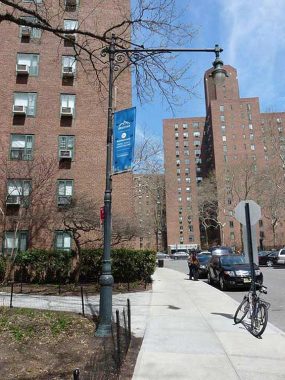
Countdown extra: Stuyvesant Town
Type: G Status: In good shape
Stuyvesant Town sits on an almost-square defined by East 14th and East 20th Street, 1st Avenue and Avenue C, with 89 buildings containing 8,757 apartments. By auto it’s accessed by a series of ovals located on its four border streets, and pedestrians can easily access its four “quadrants” via the center oval. A second residential complex, Peter Cooper Village, sits north of East 20th Street.
Not mentioned in the LPC pamphlet is that the streets in the complex are lit by dozens of Type G Corvington lampposts. They were devised for use on park roads and paths and also on some side streets. Stuyvesant Town management has maintained them masterfully and even installed a set of pendant lamps to replace the former modern Unidor fixtures.
Countdown extra: 5th Avenue and West 28th Street

Type: 24 Twin Status: Deteriorating
The LPC pamphlet overlooked this Twin at 5th Avenue and West 28th. I have a more recent shot, but I liked this one I got in 1999 when both bulbs were dayburning and backdropped by the Flatiron.
The post is still there but last time I looked only one bulb was working, and one of the glass reflector bowls had fallen off.
52. Lexington Avenue at East 43rd and 47th
Type: both Type 24A-W Status: Both gone
The LPC pamphlet lists only the bishop crook at Lex and East 43rd in front of the Graybar Building, but I was also aware of a “twin” 4 blocks away on East 47th from my 1980s days working nearby at the Photo Lettering type shop. Both of them had been eliminated by the 1990s when they were replaced by 34th Street Partnership lamps, which have attained some ubiquity in midtown.

53. 5th Avenue and West 32nd Street
Type: 24 Twin Status: Vanished
This classic Twin featured remnants of its fire alarm bracket as well as flag holders for 5th Avenue’s frequent parades. However it vanished about 2010 and the city has replaced it with just a stoplight.
To me it was notable for having both a Bell fixture and a Westinghouse “cup.”
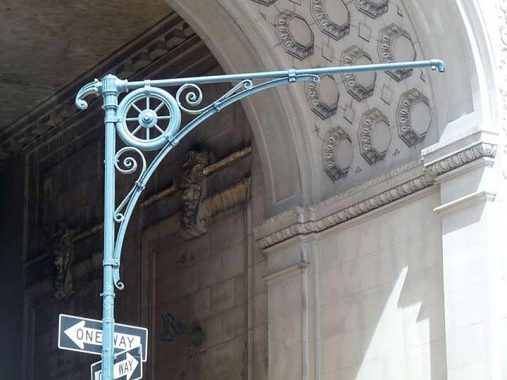
54-55. Park Avenue and East 46th Street
Type: “Wheelie” stoplight Status: Purposeless
In the mid-1920s, in response to faster and more frequent auto traffic, large stoplights appeared at busier intersections. They took the form of Type 24M Corvingtons, but with several stylistic differences including an auto wheel motif in the ironwork. At first they were one per intersection but later, two located opposite each other.
In the 1950s they began to be phased out by the modern design stoplight used today, a stouter version of the octagonal pole design used for regular streetlamps. A few hung on for dear life including a pair here at Park Avenue and East 46th, controlling traffic to and from the Park Avenue Viaduct outside Grand central Terminal.
In 2010 or thereabouts the DOT deemed the stoplight placement less than ideal and relocated them off these posts. Since they had Landmarks protection, though, they could not be torn down and today they still stand, supporting signage.

56. Beekman Place at East 51st Street
Type: 24A bishop crook Status: Excellent
This classic bishop crook has been repainted in recent years and given an LED Bell fixture. Since East 51st is lined with bishop crook repros, it can be hard to tell this one apart as a real McCoy from the early 20th Century. One way is the presence of a fire alarm lamp bracket complete with orange reflector; newer repros don’t replicate this feature.
57. Sutton Square (East 58th) and East River

Type: F Twin Status: Long gone
Type Fs did come in a Twin version. I have only seen them infrequently: in the 1970s on a southern stretch of Rockaway Boulevard; on the SUNY Maritime campus in Throgs Neck, Bronx; and here, on Sutton Square on the East Side. All have now disappeared.
This post made a cameo appearance in the Woody Allen classic Manhattan. That did not prevent it from being unceremoniously torn down in 2000, to be replaced by a retro bishop crook.

58. Edgecombe Avenue and West 158th Street
Type: Wheelie stoplight Status: Demolished
By the time I encountered this Wheelie stoplight in 1999 only the bottom part of its shaft remained, supporting pedestrian control signals. Photo evidence shows it gradually falling apart. Matt Weber, a former NYC cab driver who is also one of NYC’s most accomplished street photographers, caught this intact sight of it around 1985. The post has completely vanished.

59. Amsterdam Avenue at Hamilton Place
Type: New York Electric Company Type 6 Status: Surviving
I have a catalog of NYC lampposts produced in 1934, The System Electric Companies: Photographs of Street Lighting Equipment as of 1934, which includes the usual bishop crooks, Corvingtons and twinlamps seen elsewhere, but a great many other forms that have vanished without trace. The catalog identifies this post as a New York Electric Type 6 Twin. They had a much “busier” base, and a taller shaft, the better to spread light on major intersections. Only one of these exists today, here at Hamilton Place, West 143rd and Amsterdam Avenue, albeit in a compromised fashion.
As is the case with other old posts around town, some mixing and matching has been done, and in the case of this post, a Type 24 Variation 3 (I know, I know…) was attached decades ago to the existing Type 6 Twin base. So, we have two extinct posts in one, since the variation, easily recognized by a sharp spike at the apex, is now totally absent in the city, except for here. I call the Variation 3 the “German helmet” since it featured an upright spike finial in the center. This variation exists nowhere else but here, too.
Unfortunately the post still has its 1980s Holophane “buckets” and really should get some teardrop Bell fixtures. I show the post in detail on this FNY page.

60-62. Colonel Charles Young Triangle, Macombs Place and East 153rd Street
Type: F Status: Vanished
Within the boundaries of Col. Charles Young Park the LPC pamphlet lists a trio of Type F posts. Unfortunately all three have vanished.
63-68. Adam Clayton Powell Boulevard at East 153rd Street

Type: Special Iron Twin Standard Status: Altered unrecognizably
These posts used to light an underpass that brought traffic from Adam Clayton Powell Blvd (formerly 7th Avenue) under the Harlem River Drive. The Harlem River Drive, however, has been here only since the 1950s, and these poles, and the underpass they serve, have been here at 7th Avenue and 153rd Street longer than that.It’s likely the underpass served as a way to get traffic under and around the massive 155th Street viaduct which led to the 1895 Macombs Dam Bridge.
Around 2012 the DOT modernized them to their current appearance, stripping off the Westinghouse cuplights.
However, virtually the same type of poles still illuminate the Riverside Drive viaduct a few blocks west of here, and these still have their original 8-paned octagonal fixtures.

69. Charles and West 4th Street
Type: 6 BC Status: Decapitated
This stump, in the heart of Greenwich Village, was once a full-sized Type 6 bishop crook (see above for description). I don’t know when it lost its head. It had been listing considerably, but has been righted. Here’s a 1940 view when it was complete. The crook on the opposite corner is a recently installed retro post.

Countdown extra: Bronx bishop crook, Broadway north of West 230th
Type: 24A Status: I don’t know how it’s standing
This very old Type 24A (it has the Edison Company lightbulb symbol) is somehow still standing despite its advanced rust. It has a 1950s westinghouse “cuplight” with an extended glass reflector bowl. I don’t know if it lights up at night.
70-71. Conservatory Drive at Haupt Conservatory, NY Botanical Gardens
Type: G Status: still there, I assume
With #70, the LPC pamphlet leaves Manhattan and discusses the few landmarked lampposts in the “outer” boroughs, including a pair of Type Gs in front of the Haupt Conservatory in the Botanical Gardens in Bronx Park.
I have to confess I’ve never seen them. I’ve paid a few visits to the Gardens (you should too) but whenever I’m leaving, I’m usually hustling off to meet a Metro North train back to Grand Central, and there’s no time for lamppost hustling. If someone has a photo please pass it along in Comments.

72. Stairway lamp, Maspeth, Queens
Type: F Status: Good
This is Maspeth‘s only landmark. Let that sink in for a bit, in a part of town that once had the colonial-era DeWitt Clinton mansion and the Upjohn-designed St. Saviour’s Church. However, you take landmarks as you can get them, including this Type F post that illuminates a staircase connecting two pieces of 53rd Avenue between 64th Street and 65th Place. It used to be in sorry shape indeed but was restored in the 1990s.

73. Shore Parkway and 27th Avenue pedestrian crossing
Type: F Status: Hanging in
There are a pair of Type Fs at either end of a pedestrian crossing over the Belt Parkway at 27th Avenue (an in a countdown extra, one at another crossing at 17th Avenue. The two at 26th Avenue still have their Westinghouse cuplights (I don’t know if they illuminate). Their deep blue paint job has faded considerably in recent years. In a common lament of the Type Fs, their top finials are gone.

74. 86th Street Transverse Road, Central Park
Type: Modified Wheelie stoplight Status: Repurposed
This Wheelie, with a considerably shortened shaft, once controlled traffic at the NYPD Central Park HQ. As you can see it was repurposed during the 2000s as a streetlamp.

75-76. India House (One Hanover Square), Hanover Square between Stone and Pearl Streets
Type: C Status: OK
The India House, built in 1851, was the first site of a materials futures exchange in NYC; today it hosts restaurants. The front entrance is flanked by a pair of rare Type C lampposts, which were originally fitted with gas jets and used along parkways. Most of them have been supplanted by Type B park posts, which is the most common lamppost in NYC other than aluminum octagonal posts.

77. Nassau Street south of Spruce
Type: Bishop crook wall bracket Status: Better than ever
The last bishop crook wall bracket lamp in New York City — a genre that I don’t think was all that frequently found even in the olden age of cast iron NYC lampposts, 1900-1950. As a rule, when a wall bracket lamp was needed, the city turned to other styles, most frequently a lang-armed lamp based on the Type G posts. I featured most styles on my Wall bracket Lamps FNY page.
The lamp is affixed to a Pace University building formerly the home of The New York Times. It was designed by prolific architect George Post and went up in 1889 with extra floors added in 1906. It stands in what was formerly known as Printing House Square, because Park Row was once known for the newspapers that were centered on Park Row opposite City Hall Park, among them the Times and Horace Greeley’s New York Tribune. On the opposite corner is a monumental statue of Benjamin Franklin.
In 2019 the post was removed for servicing, and was put back with a new LED bulb and glass reflector bowl.
Phew! Should any more NYC lampposts be landmarked? Sure—the handful of remaining bronze twin Deskeys scattered on 5th Avenue between 42nd and 61st Streets. These distinctive designs, very much of their time, are now a good 55 years old, long enough to be considered classics!
Check out the ForgottenBook, take a look at the gift shop, and as always, “comment…as you see fit.”
4/12/20

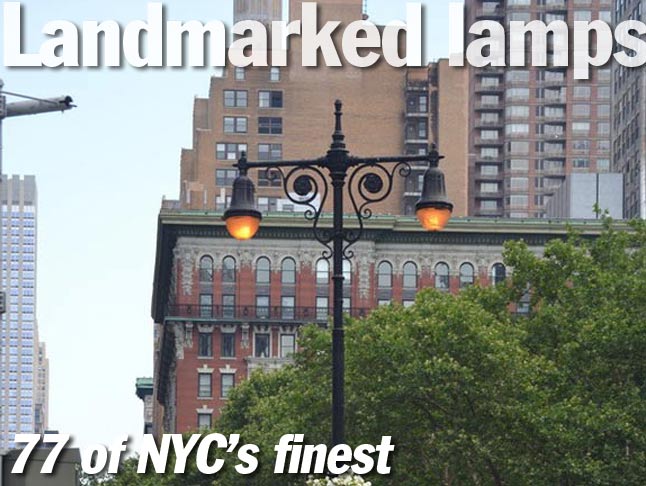



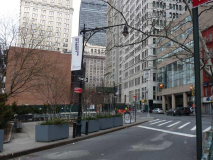


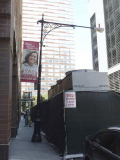



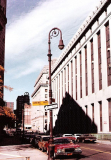





15 comments
Great piece, Kevin! If the Type Fs were designed around the 1910s, do you know how the ones at Shore Parkway and 27th Avenue (no. 73) ended up there? The parkway didn’t open until much later, as you know. Were the lampposts repurposed from elsewhere?
Designed in the 1910s, manufactured into the 30s-40s at least
Spotted two errors: Lampposts (two p’s not one). Also #52 you mean Grand Central Partnership not 34th Street Partnership.
It’s interesting that the Villard Houses, a NYCHA property, and the Helmsley Palace Hotel (the former mansion of Henry Villard) were the first recipients of the retro street light fixtures. Knowing that you are a train buff, Henry Villard was a former president of the Northern Pacific Railway in 1881-1884, among other railroads and companies.
I’m surprised you didn’t do a then and now image on these to compare those scenes to see if those street lamps were still there or replaced.
I can, but that would take a lot of time and a 1-77 countdown is pretty time consuming, for both me and the reader.
Type F twins lit the entire stretch of Linden Blvd from Kings Highway/Remsen Av. in Brooklyn east to Conduit Blvd. in Queens starting in the 1930s when Linden was widened and extended to Queens. In 1958 they were all replaced by tall octagonal poles with twin straight arms holding cup lamps. Unusually for the time, the lamps held mercury lights, probably the first in Brooklyn.
Good to know. I did not see that stretch of Linden Blvd till I took bus trips to Long Island while with the Cub Scouts in the 1960s.
Are you sure about no. 58? The sign in the photo says 139 St. Great post(s). Never cared about lampposts. Now I do, or at least I’ll look at them.
there was a crook type fixture in front of what was doghany steak house, when it was there, it was around in the early 80s it was painted tan and black withe scrollwork accented with gold leaf, i think its gone now , but until then the only crooks were in front of the random house publishing that later became the entrance to the helmsley on 49 and park. the lamp pictured may be that one, im not from that area and havent been there in a few years, ill look on google earth to verify if i have the right location.
followup to my pevious post: thats the lamp, looked better when the place was a steakhouse, dont know what those stores are now but the steakhouse was right next to the post office
Hello, I’m wondering if anyone here knows who manufactures the facsimile lampposts in Central Park – the ones that look like this: https://nypost.com/wp-content/uploads/sites/2/2016/08/lamppost.jpg?quality=90&strip=all&w=618&h=410&crop=1 and/or the similar ones in Riverside Park.
My UWS building has to replace two lampposts by the front walkway (not originals, alas long gone, but generic-looking ones that no one will miss). We’re near Riverside Park and would love to use lampposts that match or are similar to the originals there. Given the current difficulties in the city, we’re not getting any reply from the two park conservancies. Any suggestions?
I still find it amazing that these guys are still left standing in all theur beauty: https://www.google.com/maps/@40.7813596,-73.9872271,3a,75y,259.05h,75.56t/data=!3m7!1e1!3m5!1s3kb2j-lPmxWYTYOGSzdZSQ!2e0!3e11!7i16384!8i8192 …. as well as these up on the 150s: https://www.google.com/maps/@40.8367191,-73.9484679,3a,75y,349.27h,89.89t/data=!3m7!1e1!3m5!1sc5pfSPp6FShFjE97o_vztA!2e0!6s%2F%2Fgeo0.ggpht.com%2Fcbk%3Fpanoid%3Dc5pfSPp6FShFjE97o_vztA%26output%3Dthumbnail%26cb_client%3Dmaps_sv.tactile.gps%26thumb%3D2%26w%3D203%26h%3D100%26yaw%3D225.20966%26pitch%3D0%26thumbfov%3D100!7i16384!8i8192
Though I no longer live in NY, I am delighted to see the widespread introduction of “retro” bishops crook and twin lamps. They are really quite beautiful designs ,a Happy combination of beauty and function. I was in high school in the mid 60s and recall writing to the city to complain of their removal. I am now vindicated!
I just shared this page with the folks at SimTropolis, where they discuss SimCity4 and designing cities. Folks there have great interest in creating sooper-dooper simulated cities, and I share with them all kinds of New York trivia, being a fourth-generation native New Yorker.